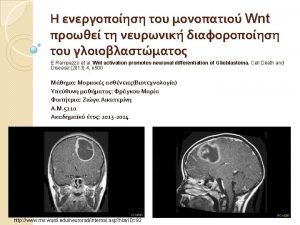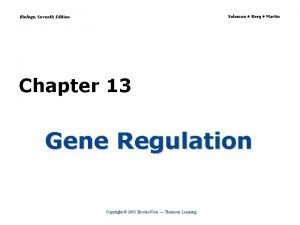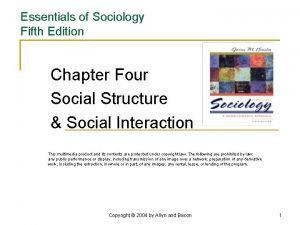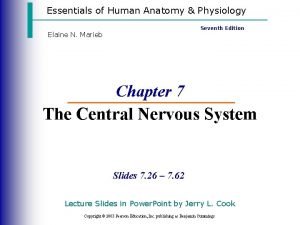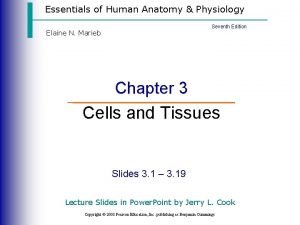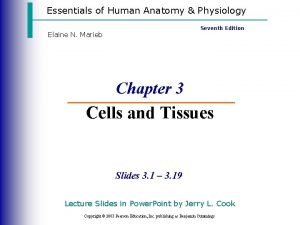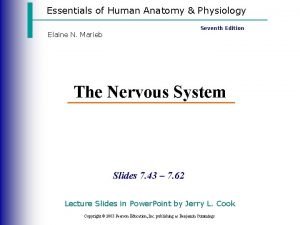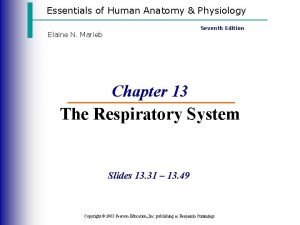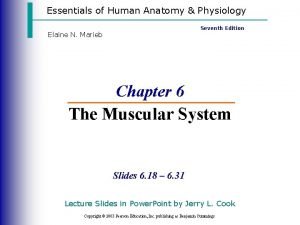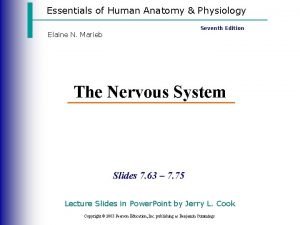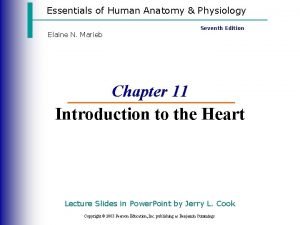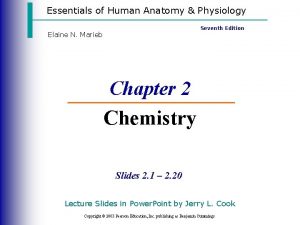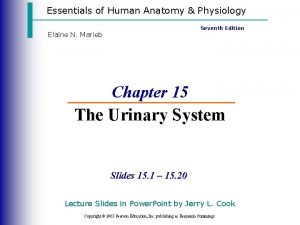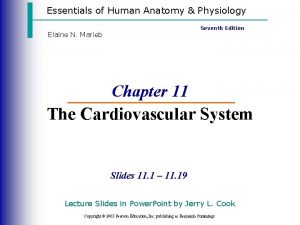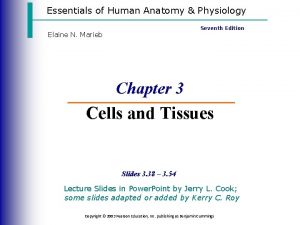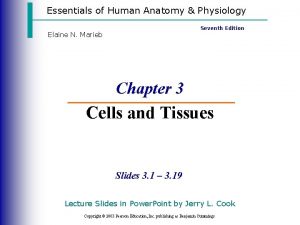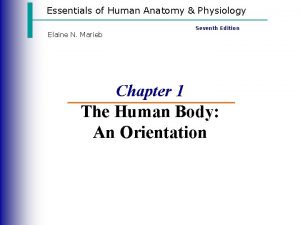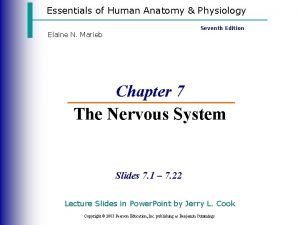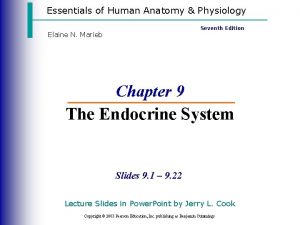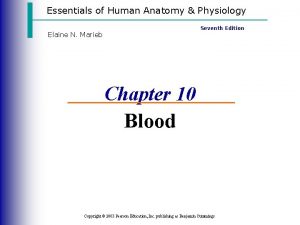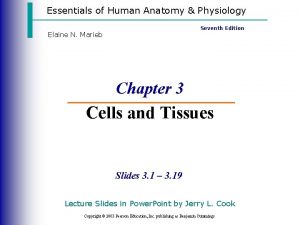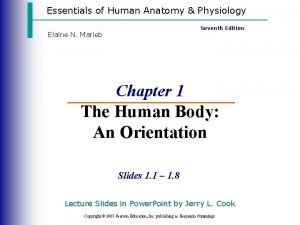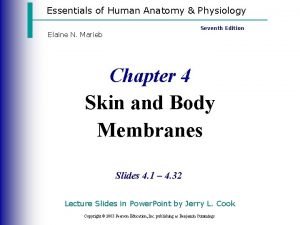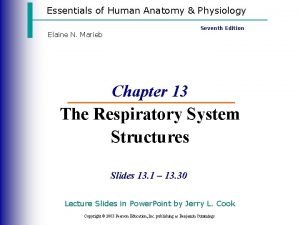Essentials of Human Anatomy Physiology Seventh Edition Elaine







































- Slides: 39

Essentials of Human Anatomy & Physiology Seventh Edition Elaine N. Marieb Chapter 1 The Human Body: An Orientation Slides 1. 1 – 1. 8 Lecture Slides in Power. Point by Jerry L. Cook Copyright © 2003 Pearson Education, Inc. publishing as Benjamin Cummings

The Human Body – An Orientation • Anatomy – study of the structure and shape of the body and its parts • Physiology – study of how the body and its parts work or function

Anatomy – Levels of Study • Gross Anatomy • Large structures • Easily observable

Anatomy – Levels of Study • Microscopic Anatomy • Very small structures • Can only be viewed with a microscope

Levels of Structural Organization

Organ System Overview • Integumentary • Forms the external body covering • Protects deeper tissue from injury and drying out • Synthesizes vitamin D • Location of cutaneous nerve receptors

Organ System Overview • Skeletal • Protects and supports body organs • Provides muscle attachment for movement • Site of blood cell formation • Stores minerals

Organ System Overview • Muscular • Allows locomotion • Maintains posture • Produces heat

Organ System Overview • Nervous • Fast-acting control system • Responds to internal and external change • Activates muscles and glands

Organ System Overview • Endocrine • Secretes regulatory hormones • Growth • Reproduction • Metabolism

Organ System Overview • Cardiovascular • Transports materials in body via blood pumped by heart • Oxygen • Carbon dioxide • Nutrients • Wastes

Organ System Overview • Lymphatic • Returns fluids to blood vessels • Disposes of debris • Involved in immunitydestroys bacteria and tumor cells

Organ System Overview • Respiratory • Keeps blood supplied with oxygen • Removes carbon dioxide

Organ System Overview • Digestive • Breaks down food • Allows for nutrient absorption into blood • Eliminates indigestible material

Organ System Overview • Urinary • Eliminates nitrogenous wastes • Maintains acid – base balance • Regulation of materials • Water • Electrolytes

Organ System Overview • Reproductive • Production of offspring

Necessary Life Functions • Maintain Boundaries- keeps the body’s internal environment distinct from the external environment- the skin and membranes • Movement • Locomotion • Movement of substances • Responsiveness • Ability to sense changes and react • Digestion • Break-down and delivery of nutrients

Necessary Life Functions • Metabolism – all chemical reactions within the body • Production of energy • Making body structures • Excretion • Elimination of waste from metabolic reactions

Necessary Life Functions • Reproduction • Production of future generation • Provides new cells for growth and repair • Growth • Increasing of cell size and number

Survival Needs • Nutrients • Chemicals for energy and cell building • Includes carbohydrates, proteins, lipids, vitamins, and minerals • Oxygen • Required for chemical reactions

Survival Needs • Water • 60– 80% of body weight • Provides for metabolic reaction • Stable body temperature • Atmospheric pressure must be appropriate

Homeostasis • Maintenance of a stable internal environment = a dynamic state of equilibrium • Homeostasis must be maintained for normal body functioning and to sustain life • Homeostatic imbalance – a disturbance in homeostasis resulting in disease

Maintaining Homeostasis • The body communicates through neural and hormonal control systems • Receptor • Responds to changes in the environment (stimuli) • Sends information to control center

Maintaining Homeostasis • Control center • Determines set point • Analyzes information • Determines appropriate response • Effector • Provides a means for response to the stimulus


Feedback Mechanisms • Negative feedback • Includes most homeostatic control mechanisms • Shuts off the original stimulus, or reduces its intensity • Works like a household thermostat


Feedback Mechanisms • Positive feedback • Increases the original stimulus to push the variable farther • In the body this only occurs in blood clotting and birth of a baby


The Language of Anatomy • Special terminology is used to prevent misunderstanding • Exact terms are used for: • Position • Direction • Regions • Structures

Orientation and Directional Terms Table 1. 1

Orientation and Directional Terms

Body Landmarks • Anterior

Body Landmarks • Posterior

Body Planes

Body Cavities

Abdominopelvic Quadrants

Abdominopelvic Major Organs

 3 layers of muscle
3 layers of muscle Uterus perimetrium
Uterus perimetrium Anatomy and physiology edition 9
Anatomy and physiology edition 9 Waistline
Waistline Holes essential of human anatomy and physiology
Holes essential of human anatomy and physiology Chapter 1 introduction to human anatomy and physiology
Chapter 1 introduction to human anatomy and physiology Chapter 2 human reproductive anatomy and physiology
Chapter 2 human reproductive anatomy and physiology Database system concepts seventh edition
Database system concepts seventh edition Information systems literacy
Information systems literacy Molecular biology of the cell seventh edition
Molecular biology of the cell seventh edition Biology seventh edition
Biology seventh edition Human anatomy fifth edition
Human anatomy fifth edition Human anatomy fifth edition
Human anatomy fifth edition William stallings network security essentials 5th edition
William stallings network security essentials 5th edition Business essentials 12th edition chapter 1
Business essentials 12th edition chapter 1 Essentials of investments 11th edition
Essentials of investments 11th edition Business essentials 12th edition
Business essentials 12th edition Essentials of sociology 5th edition
Essentials of sociology 5th edition Firefighter essentials 7th edition
Firefighter essentials 7th edition Business essentials 12th edition
Business essentials 12th edition Essentials of mis, 13th edition
Essentials of mis, 13th edition Essentials of organizational behavior 14th edition
Essentials of organizational behavior 14th edition At a bulk transport incident firefighters must
At a bulk transport incident firefighters must Cryptographic systems are generically classified by
Cryptographic systems are generically classified by Criminal justice wedding cake diagram
Criminal justice wedding cake diagram Physiology of sport and exercise 5th edition
Physiology of sport and exercise 5th edition Upper respiratory tract labeled
Upper respiratory tract labeled Tattoo anatomy and physiology
Tattoo anatomy and physiology Anatomy science olympiad
Anatomy science olympiad External parts of a leaf
External parts of a leaf Anatomy and physiology bones
Anatomy and physiology bones Peptic ulcer disease anatomy
Peptic ulcer disease anatomy Liver physiology and anatomy
Liver physiology and anatomy Epigastric region
Epigastric region Epigastric vs hypogastric
Epigastric vs hypogastric Straw colored fluid
Straw colored fluid Chapter 14 anatomy and physiology
Chapter 14 anatomy and physiology Http://anatomy and physiology
Http://anatomy and physiology Appendix physiology
Appendix physiology Aohs foundations of anatomy and physiology 1
Aohs foundations of anatomy and physiology 1









